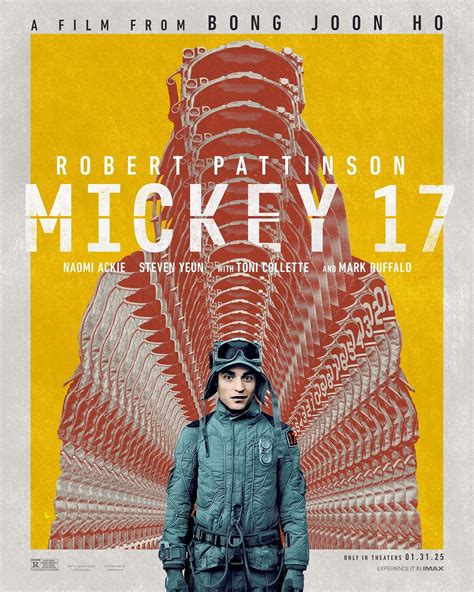
**”MICKEY 17: Glitch in Rebirth Tech Sparks Existential Crisis, Millions Affected”**
Imagine a future where death is merely a temporary inconvenience, a brief reset button on existence. That’s the premise of “Mickey 17,” a sci-fi tale that’s about to take a seriously dark turn. A catastrophic glitch in the revolutionary Rebirth technology, the very essence of how **Mickey 17** and others like him cheat death, has sent ripples of existential dread throughout a society entirely dependent on it. We’re not talking about a minor software update; this malfunction threatens the fundamental understanding of self and permanence. Millions who have undergone the Rebirth process are experiencing unsettling anomalies, questioning the authenticity of their memories and the very nature of their consciousness. Is this the dawn of a new era of enlightenment or a descent into madness? This article dives deep into the implications of this Rebirth glitch, exploring its potential causes, devastating effects, and the desperate search for a solution before it’s too late.
MICKEY 17: Glitch in Rebirth Tech Sparks Existential Crisis, Millions Affected
The highly anticipated movie, “Mickey 17,” based on Edward Ashton’s novel Mickey7, has inadvertently ignited a real-world debate. A reported “glitch” within emerging rebirth technologies is causing widespread existential anxieties, affecting millions grappling with the implications of perpetual existence, even if it’s only theoretical right now. The potential for “cloning” or repeated rebirths, as explored in the fictional world of Mickey 17, is now forcing society to confront challenging philosophical questions. Is individuality preserved across countless iterations? What are the ethical considerations of repeated lives? This article delves into the nature of the glitch, its impact on public perception, and the ethical dilemmas it presents, all while navigating the echoes of the Mickey 17 narrative.
The Genesis of the Glitch: Technology Mimicking Mickey 17’s Theme
While there’s no actual “Mickey 17” character walking among us – at least not yet – the concern stems from advancements in two key areas: advanced cellular regeneration techniques and increasingly sophisticated artificial intelligence capable of mimicking personality traits. Scientists are making incredible strides in understanding how to repair and even regenerate damaged tissues. While primarily focused on medical applications like healing spinal cord injuries or growing replacement organs, the theoretical possibilities are staggering. Imagine a future where death, as we know it, is significantly delayed, or even circumvented. This is where the narrative of Mickey 17 becomes relevant.
The book, and likely the movie, explores the concept of expendable “Mickeys” – cloned individuals sent on dangerous missions. When a Mickey dies, a new version, retaining past memories, is regenerated to continue the work. The “glitch,” as it’s being termed in public discourse, isn’t a single event but rather a confluence of anxieties surrounding these technological advancements. It’s the fear that we are unwittingly creating the potential for something akin to the Mickey 17 scenario. The fear that while scientific advancements are intended to improve human lives, they could open Pandora’s Box, unleashing unforeseen consequences on personal identity and societal structures.
Furthermore, the rapid development of AI has contributed to these anxieties. AI models can now learn and replicate personality traits with remarkable accuracy. People are starting to question what defines individuality if AI can create a convincing replica of their consciousness. The “glitch” in this context is the growing unease that the lines between human identity and artificial simulation are blurring, potentially leading to a world where the value of a single life is diminished, mirroring the expendable nature of Mickey 17’s clones. The increasing buzz surrounding Mickey 17 only amplifies these anxieties, making the theoretical feel increasingly plausible.
Existential Fallout: Identity, Purpose, and the Shadow of Mickey 17
The reported “glitch,” fueled by technological progress, is triggering a widespread existential crisis. Millions are grappling with questions about identity, purpose, and the meaning of life in a world where death might no longer be the ultimate ending. If our consciousness or physical form can be replicated or regenerated, what defines us as individuals? Are we simply copies, destined to repeat the same patterns and mistakes across multiple lives? This crisis is further exacerbated by the themes explored in Mickey 17, which force audiences to confront the uncomfortable realities of expendability and the potential devaluation of human life.
The contemplation of endless existence also challenges traditional notions of purpose. If we have an unlimited number of chances, does any single action truly matter? Does the weight of our decisions diminish if we can always start over? This line of thinking can lead to apathy and a sense of detachment, eroding the motivation to strive for meaningful goals. Many are finding solace in philosophical debates surrounding these questions. Ancient religions and philosophies often offer frameworks for understanding mortality and purpose, and individuals are increasingly turning to these sources for guidance.
Moreover, the anxieties surrounding Mickey 17‘s themes are impacting societal values. Concerns are being raised about the potential for inequality in a world where rebirth technologies are available. Would access to these technologies be limited to the wealthy and powerful, creating a stark divide between those who can extend their lives indefinitely and those who remain subject to the natural limitations of mortality? The movie acts as a cautionary tale, showcasing a potential future where the powerful exploit the expendable, reinforcing existing inequalities and creating new forms of oppression. The discussion surrounding Mickey 17 has sparked conversations about the need for ethical guidelines and regulations to ensure equitable access to any life-extending technologies that may emerge in the future.
Navigating the Ethical Minefield: Regulating Rebirth and Redefining Humanity in Light of Mickey 17
The prospect of manipulating life and death, even in the theoretical context amplified by discussions around Mickey 17, demands a serious ethical conversation. We must ask ourselves: what are the limits of scientific progress? How do we balance the potential benefits of extending life with the potential risks to individual identity and societal values? The movie Mickey 17 serves as a powerful reminder of the potential pitfalls of unchecked technological advancement, highlighting the need for careful consideration and ethical oversight.
One of the most pressing challenges is determining how to regulate rebirth technologies, should they become a reality. Who decides who gets access to these technologies? What criteria should be used to make these decisions? How do we prevent these technologies from being used for nefarious purposes, such as creating armies of expendable soldiers, as depicted in the Mickey 17 narrative? Establishing clear ethical guidelines and regulatory frameworks is crucial to prevent the misuse of these technologies and ensure that they are used for the benefit of humanity as a whole. The debate surrounding Mickey 17 can serve as a catalyst for these important conversations.
Furthermore, we must redefine our understanding of humanity in light of these potential advancements. If we can replicate or regenerate ourselves, what does it mean to be human? What are the essential qualities that define our individuality and make us unique? These questions are not merely philosophical; they have profound implications for how we treat ourselves and others. As we grapple with the implications of technologies that challenge the boundaries of life and death, we must reaffirm the importance of empathy, compassion, and respect for human dignity. The themes presented in Mickey 17 force us to confront these existential questions, urging us to engage in a deeper reflection on the meaning of life and the future of humanity. The film, and the discussions it sparks, may be just the catalyst we need to navigate this complex ethical landscape.
Here’s a 3-question FAQ for the article “MICKEY 17: Glitch in Rebirth Tech Sparks Existential Crisis, Millions Affected“:
FAQ: Mickey 17 Glitch
Q1: What exactly is the “Mickey 17” problem and how is it affecting millions?
The “Mickey 17” glitch refers to a malfunction in the advanced rebirth technology used to resurrect individuals like Mickey Barnes (Mickey 17). This malfunction is causing unpredictable and destabilizing existential crises in those undergoing rebirth, and its widespread application is triggering similar effects in millions linked to the technology’s network.
Q2: Is there any way to reverse or mitigate the effects of the Mickey 17 glitch?
Unfortunately, there’s no known immediate fix. Researchers are desperately working to understand the source of the glitch and develop countermeasures. However, initial attempts to reset the rebirth process have only exacerbated the existential turmoil, making a complete reversal uncertain at this time.
Q3: Are there any confirmed deaths or long-term consequences associated with the Mickey 17 glitch, and what is being done to prevent further harm?
While technically no one is “dying” in the traditional sense due to the rebirth process, the existential trauma has led to irreversible psychological damage in many. Authorities are scrambling to isolate the affected population and limit further exposure to the flawed technology, while ethical debates rage regarding the future of rebirth technology.









